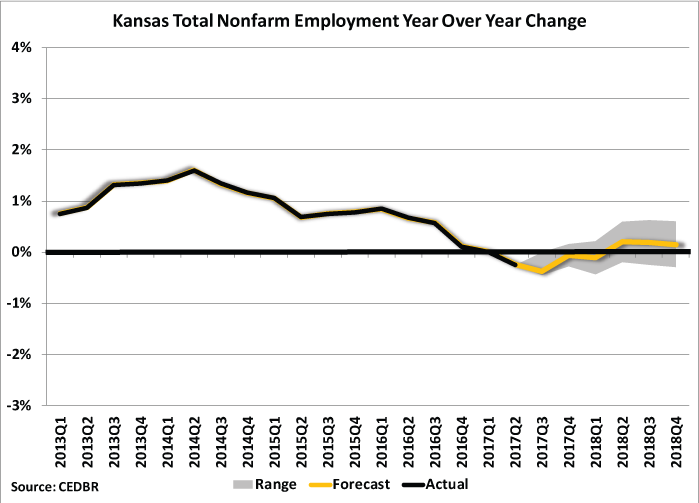Kansas Employment Forecast
Released October 5, 2017 (See previous version.)
From July 2016 to July 2017, Kansas employment has declined by 0.8 percent, a decrease of approximately 10,800 jobs. In 2018, Kansas total nonfarm employment is projected to increase by 0.1 percent, adding approximately 1,500 jobs, with a range of expected growth between negative 0.3 percent and positive 0.5 percent. Growth is expected to be lower than Kansas’ average employment growth rate over the last five years, which has been 1 percent.
- Employment in the production sectors are projected to decline by 0.3 percent in Kansas, contracting by over 700 jobs in 2018. While the construction sector is expected to expand, the manufacturing and natural resources sectors are both projected to decline, with the largest declines in durable goods manufacturing. Manufacturing employment has declined each year in Kansas since 2015.
- Trade, transportation and utilities sector employment is expected to grow 0.2 percent, adding approximately 600 new jobs. The wholesale trade sector and the transportation and utilities sector are projected to grow 0.8 percent and 1.8 percent, respectively. The retail trade sector, however, is projected to decline by 0.7 percent in 2018. This is a reflection of weak growth in retail sales in Kansas recently; from May 2016 to May 2017, inflation-adjusted taxable retail sales for the state declined by 3.3 percent.
- The service sectors are projected to lead Kansas growth in 2018, with 0.4 percent growth, adding approximately 2,700 jobs. The professional and business services sector, health care sector, and the financial activities sector are forecast to add approximately 3,800 jobs, collectively. The drivers for this growth are expected to be an aging population and broader national growth in the service industries. The information and other services sectors are projected to lose 1,000 and 800 jobs, respectively.
- The government sector is expected to decline by approximately 1,000 jobs in 2018, declining 0.4 percent. Local, state and federal government employment are all projected to decline, with the largest declines at the local level.
- The Topeka, Kansas City, and Wichita metropolitan areas are all expected to grow at rates faster than the state average in 2018, with a combined average growth rate of 0.9 percent. Excluding these three MSAs, the remainder of the state is forecast to experience an employment decline of approximately 1.2 percent, in part due to declines in some core sectors, such as mining and agriculture.
| DOWNLOAD PDF VERSION |









